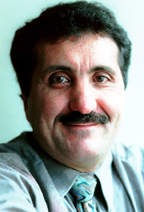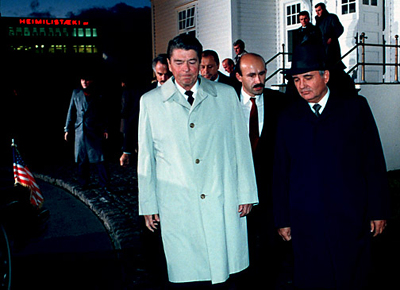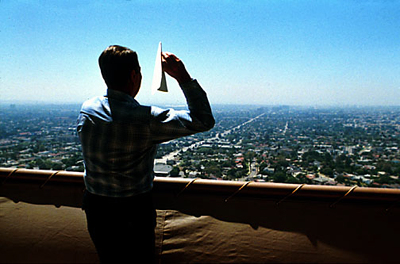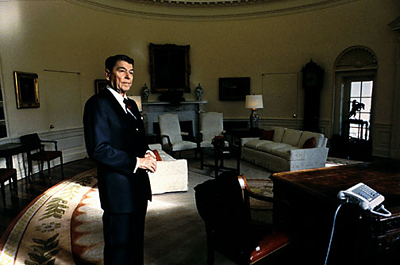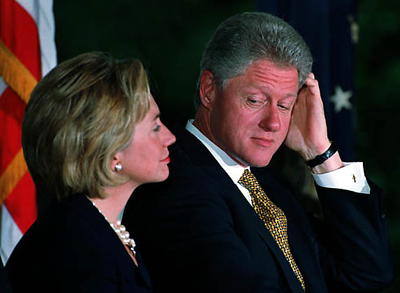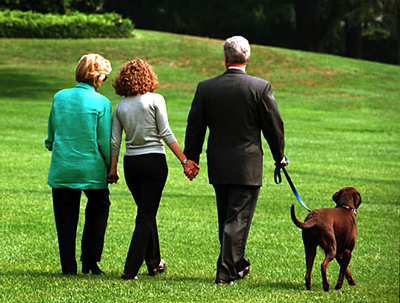| Home | Blog | Ask This | Showcase | Commentary | Comments | About Us | Contributors | Contact Us |

Lecture and Q&A: Photography With Pete Souza
May 1999 [Pete Souza is The Chicago Tribune's national photographer based in its Washington bureau. His photographs appear frequently on page one of The Tribune and in the newspaper's Sunday magazine. Prior to joining the Tribune in January 1998, Souza worked as a freelancer in Washington. He has photographed two articles on assignment for National Geographic magazine and three photo essays for Life magazine. His photographs have also been published in hundreds of other magazines and newspapers. In 1992, Souza produced and published "Unguarded Moments: Behind-the-Scenes Photographs of President Reagan," a coffee-table book based on his 5 1/2 years as official White House photographer. Former Senator Howard Baker Jr. said in his introduction to the book that Souza recorded "some of the most intimate, honest and humanizing scenes of the presidency I've ever seen." Souza has won numerous photojournalism awards including five times in the prestigious Pictures of the Year annual competition. As a staff photographer for The Chicago Sun-Times in the early 1980's, he was named 1982 Illinois Newspaper Photographer of the Year. Souza is a native of South Dartmouth, MA. He graduated cum laude with a bachelor of science degree in public communications from Boston University and attended graduate school at Kansas State University.] I'm not sure I'm going to show you how to deal with sources as much as how to deal with The Source, the Big Kahn. What I thought I would do is show you some of my pictures from the Reagan Administration as an insider when I was the arm of government. I was a White House staffer working for the White House, covering President Reagan. Then how that differs from how I covered President Clinton last year, during his impeachment year. In a lot of ways I think that I was more a journalist covering Reagan as an employee of the government than I was covering Clinton as a newspaper photographer for The Chicago Tribune. Behind the Scenes With ReaganI'm just going to show you pictures behind the scenes with Reagan, so you can get a sense of where I come from in terms of trying to cover Clinton today. I'm the biggest cynic when it comes to photographing a president now.
Photo: Pete Souza/The White House This is the breakup of the Reykjavik Summit in 1986. Incidentally, when these guys got to the limo and they had a final conversation, I was between a KGB agent and a Secret Service agent, and through the interpreters I listened to that whole last conversation and when I got back to the motorcade, at the time Pat Buchanan was the communications director, I had to tell somebody what they had just said, and I'll never forget this, he pointed his finger at me and said, "You write this down right now, write it down, what you just told me." So I wrote it down and then [Press Secretary] Larry Speakes got a hold of me and the last three lines of the conversation was in the next Monday's Time magazine in big, bold print. I'm saying to myself, god, I hope I didn't get it wrong. [Laughter] Q - What was it? A. - Oh, it was pretty cryptic stuff like Gorbachev said to Reagan, "I don't know what else I could have done," and Reagan said, "You could have said yes," meaning SDI, and I honestly can't remember the rest of the conversation. But it is in Time magazine.
Photo: Pete Souza/The White House Throwing a paper airplane off the top floor of - I forget the name of the hotel, in L.A. He hated this picture. I showed it to him a couple days after I had made the picture, I had made a print and gave it to him, because it was such a unique moment, and he basically told me he didn't really like it, he thought it kind of made fun of him, and I said, "Mr. President, it shows there's a little bit of kid in you just like there is in all of us." He's throwing a paper airplane off the top floor of this hotel building. The last time I visited him, which was in 1992, I was happy to see that that print that I gave him, which I signed, was right next to the picture of him with Queen Elizabeth, on his desk at home.
Photo: Pete Souza/The White House This is the last day in the Oval Office, January 20th, 1989, just one brief moment where he was in the office alone - alone with me. He was just looking around. Now I'm going to talk to you about covering Clinton during the impeachment year and what a complete shock it was for me to go from this kind of access to covering Clinton. I was a freelancer for nine years after I left the White House, and this job offer came along for The Chicago Tribune in the Washington bureau, and I said this is great, but I don't want to cover the White House, I don't want to cover Capitol Hill, and they said, "We want you to be our East Coast guy, do some foreign trips," and I figured I'd give it a shot. We were doing a story on Bill Daley, the Secretary of Commerce. He being from Chicago, it was kind of a big deal. We were doing a magazine story, so I traveled with him to Turkey and Greece, and I was in Turkey and his press secretary had the TV on and there was Joe Lockhart trying to defend away the latest accusation about Clinton, and it was the Monica Lewinsky story. That became my year. Really last year that's pretty much all I did, and it was not a pleasant experience. It was kind of the "Truman Show." I tell people with Clinton, he's a guy on stage - this is the way I look at it - and he could show you five different faces during any one appearance, and I transmit my photos digitally to Chicago every day, and the most difficult thing is which one do I send, because I don't know which one is the true moment, which one do I send. I swear to god, I can make him look anyway you want to match a story of the day. Do you send him the pensive look?
Photo: Pete Souza/The White House You show him with Mrs. Clinton, this was the day that the Starr Report was released.
Photo: Pete Souza/The White House This was the day when he finally admitted the affair - actually, I guess it was the day after and he was going to Martha's Vineyard for vacation. There's like 50 photographers out there for the 32nd walk to go from the White House to the helicopter. This is journalism? It's like for one moment leaning toward Hillary and it becomes like the decisive moment. But does that really tell you what was going on? Then towards the end of the year, when it looked like he was going to get impeached, he sort of changed his game face. When he appeared publicly it was more showing that his staff is behind him, it's the happy face, kind of a little smirk, almost. But whether it's a true moment, I don't know, it's so hard to tell. I felt I covered Reagan and did it journalistically and presented the right photographs of him, and with Clinton I really don't know if I did a journalistic job or not. Q. & A. Q - Do presidents treat you as a photographer, like you're deaf and dumb, as you go about your work, or do you think they are guarded because of your presence, and fearful that you'll either run to your press colleagues or people, depending on whether you were on the White House staff or working for The Tribune. Are you a potted palm or are you a reporter? A. - Are you talking about when I was working for the White House? Q - Both. A. - I think it probably differs from president to president. The Clinton Administration thinks photographers are scum, basically. The title of my book was Unguarded Moments, because he was such a stage-directed president, "stand here, do this, stand there, do that," that I thought, I hope that I was able to give some sense of what he was like when he was unguarded. I think he got so used to me - there was a staff of photographers, so there was always one of us around, that I don't think he really gave a shit if we were around, he really didn't, it didn't bother him a bit. Now, I do know that Clinton's photographers have gotten great access, too, and it'll be interesting to hear their stories when this administration is over; we can hear their firsthand experiences with Clinton. I don't know what that'll be, what they'll say. Q. - I spent the second term at the Reagan White House as an AP reporter, and I never felt, probably because of Iran Contra, god, even worse, we never saw the real Reagan until the last trip with him which was his last flight on Election Day out to California to vote. It turned out the pool was all female, just by sheer chance. He came back to the back of the plane with all these flowers and actually spent some time talking with us, and it bothered me so much that for four years we hadn't connected with the guy and yet we were supposed to be there every minute with him. It bothered me that we didn't have a chance to tell America about what this guy was like. You had such access; did you see that at all in the print reporting of what was going on with Reagan? There was more there there, but we never got a chance to see it. I don't know if that's off the mark or not. A. - No, I think it's right on the mark. I think he had a lot of good attributes about him that because they kept him so guarded you never saw. He also had a lot of flaws that would have come out that everybody pretty much knew about. He was kind of lazy and he wasn't the smartest guy in the world; I think Clinton's a lot smarter than Reagan, but he worried about three big issues and that's what he cared about, and he cared about them passionately. I don't think that ever came across. I'll never forget when it was the '88 campaign, Bush was running, and Reagan, what can he do? He can help Bush a little bit, and he was starting to get really ticked off about all the Iran Contra stories, how they were off the mark, they weren't on the mark, and Reagan wanted to go out and defend why he did what he did. I'll never forget this, and I've told it to Edmund Morris who's writing the definitive biography of Reagan, saying, you've go to get a hold of this piece of paper, and Reagan, when he did write a speech, it was the most incredible thing. He would take yellow lined paper, the long paper like this, and he would write out a speech and there wouldn't be a word crossed off. I found that so astounding. He came back on Air Force One and he had written out about a page-and-a-half, and he read it to the staff of why he originally got involved in dealing with the Iranians and what he had hoped to accomplish. To me, it was very articulate and it communicated exactly what he felt, and Ken Duberstein who was then the chief of staff said, "I'll run this by Jim Baker," who was Bush's campaign manager, which meant it ain't ever going to fly, because all it will do is just bring up more questions about Iran Contra. Q - Explain to the uninitiated here what the rules are about who controls those photographs and when are you able to publish them? A. - The White House photo office is kind of a strange entity in that we don't really report to anybody. We didn't report to anybody - on paper, the chief of staff, but we're sort of our own entity. We just do our thing; we figure out what our own rules are, what we can do, and it's based mostly on our relationship with the President, he's the guy that can really say to you, "Leave the room," or, "Don't leave the room." I came in '83, so I was in the middle of the first term, and I didn't know all the players, I was a stranger to them, my access wasn't very good, but then by the time '85 rolls around, everybody's left and there's all new people coming in and they already see that I've established this relationship with Reagan so nobody ever messed with me, I could do whatever I wanted, essentially. The good part about that is we were a totally separate entity from the press office, so they don't control what kind of pictures we take or don't take. Where they do come into play is they have access to all our stuff. So if they're trying to make a PR point - what was the President's involvement with the crisis in the Philippines? - they'll go back our film the last three weeks and say, "Look, here's all the meetings Reagan was at, let's release this one to the AP and Time magazine." So we didn't have any control over that. One of the reasons that I published a book was because I had all these great photos that had never been published and nobody had ever seen. Q - Did you have control of the film? A. - No, the film belongs to me and you. It essentially goes to the National Archives and then, when the Presidential Library is built, it goes to the Presidential Library. What I did is I kept track of which pictures I thought were the most important ones, moments that showed him not only as a president but as a human being. I just sort of kept track of those, and after I left I had to go back to the Archives and buy back my own pictures, like any taxpayer could do. But because I had such a running track of it, I thought I put together a pretty good collection. Anybody else could do the same thing, but it would probably take them five years to go through 40,000 rolls of film, figure out which pictures are the key pictures. I sort of kept track of those things along the way. |

